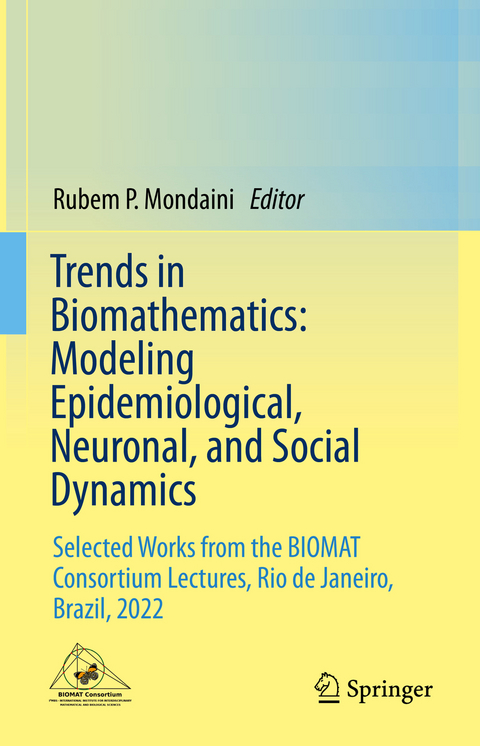
Trends in Biomathematics: Modeling Epidemiological, Neuronal, and Social Dynamics
Springer International Publishing (Verlag)
978-3-031-33049-0 (ISBN)
This volume gathers together selected peer-reviewed works presented at the BIOMAT 2022 International Symposium, which was virtually held on November 7-11, 2022, with an organization staff based in Rio de Janeiro, Brazil.
Topics touched on in this volume include infection spread in a population described by an agent-based approach; the study of gene essentiality via network-based computational modeling; stochastic models of neuronal dynamics; and the modeling of a statistical distribution of amino acids in protein domain families. The reader will also find texts in epidemic models with dynamic social distancing; with no vertical transmission; and with general incidence rates. Aspects of COVID-19 dynamics: the use of an SEIR model to analyze its spread in Brazil; the age-dependent manner of modeling its spread pattern; the impact of media awareness programs; and a web-based computational tool for Non-invasive hemodynamics evaluation of coronary stenosis are also covered.Held every year since 2001, The BIOMAT International Symposium gathers together, in a single conference, researchers from Mathematics, Physics, Biology, and affine fields to promote the interdisciplinary exchange of results, ideas and techniques, promoting truly international cooperation for problem discussion. BIOMAT volumes published from 2017 to 2021 are also available by Springer.
lt;p>Rubem P. Mondaini is President of the BIOMAT Consortium/International Institute for Interdisciplinary Sciences and a Full Professor of Mathematical Biology and Biological Physics at the Federal University of Rio de Janeiro, Brazil. He holds a PhD in Theoretical Physics from the Brazilian Centre for Physical Research, Brazil. His research activities abroad include a period as a Visiting Scientist at the International Centre for Theoretical Physics (ICTP), Trieste, Italy (1978) and as a Senior Postdoc at the Department of Mathematics of King's College, University of London, UK (1986). He was also a Visiting Professor at the Centre of Physics of Condensed Matter, Lisbon, Portugal (1986) and at the Department of Chemical Engineering of Princeton University (2008). He has been the Chairman of the Annual BIOMAT Conferences since their inception during the BIOMAT 2001 Symposium in Rio de Janeiro, Brazil.
Dynamics of an SIS Epidemic Model with no Vertical Transmission.- Infection Spread in Populations: An Agent Based Model.- Network-based Computational Modeling to unravel Gene Essentiality.- Nonlinear Dynamics in an SIR model with Ratio-Dependent Incidence and Holling type III Treatment Rate Functions.- Comparative Study of Deterministic and Stochastic Predator Prey System incorporating a Prey Refuge.- Mathematical Modeling and Numerical Analysis of HIV-1 Infection with long-lived infected cells during Combination Therapy and Humoral Immunity.- A Reaction-Diffusion Fractional Model for Cancer Virotherapy with Immune Response and Hattaf Time-Fractional Derivative.- A Review of Stochastic Models of Neuronal Dynamics: From a Single Neuron to Networks.- Modeling the Impact of Media Coverage on the Spread of Infectious Diseases: The curse of 21st Century.- Cultural and Biological Transmission: A Simple Case of Evolutionary Discrete Dynamics.- The Maximal Extension ofthe Strict Concavity Region on the Parameter Space for Sharma-Mittal Entropy Measures - II.- An Eco-epidemic Predator-Prey Model with Selective Predation and Time Delays.- Epidemic Patterns of Emerging Variants with Dynamical Social Distancing.- On Time-delayed Two-strain Epidemic Model with General Incidence Rates and Therapy.- Clustering of Countries based on the Associated Social Contact Patterns in Epidemiological Modelling.- Multiple Predation on Prey Herding and Counteracting the Hunting.- Benefits of Application of Process Optimization in Pharmaceutical Manufacturing - A Panoramic View.- AWeb-based Non-invasive Estimation of Fractional Flow Reserve (FFR): Models, Algorithms and Application in Diagnostics.- Perturbing Coupled Multi-variable Systems.- Analysis of Covid-19 dynamics in Brazil by recursive state and parameter estimations.- Computational Modeling of Membrane Blockage via Precipitation: a 2D Extended Poisson-Nernst-Planck Model.- Index.
| Erscheinungsdatum | 26.07.2023 |
|---|---|
| Zusatzinfo | X, 392 p. 118 illus., 97 illus. in color. |
| Verlagsort | Cham |
| Sprache | englisch |
| Maße | 155 x 235 mm |
| Gewicht | 763 g |
| Themenwelt | Informatik ► Weitere Themen ► Bioinformatik |
| Mathematik / Informatik ► Mathematik | |
| Studium ► Querschnittsbereiche ► Epidemiologie / Med. Biometrie | |
| Naturwissenschaften ► Biologie ► Ökologie / Naturschutz | |
| Schlagworte | Biomathematics • Computational modeling • Covid-19 • epidemiological modeling • FFR • Fractional Flow Reserve • HIV-1 • Mathematical Modeling • neuronal dynamics • Predator-prey models • SIR • sis |
| ISBN-10 | 3-031-33049-8 / 3031330498 |
| ISBN-13 | 978-3-031-33049-0 / 9783031330490 |
| Zustand | Neuware |
| Haben Sie eine Frage zum Produkt? |
aus dem Bereich


